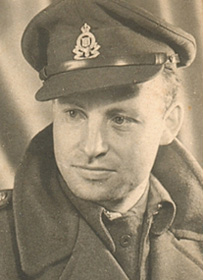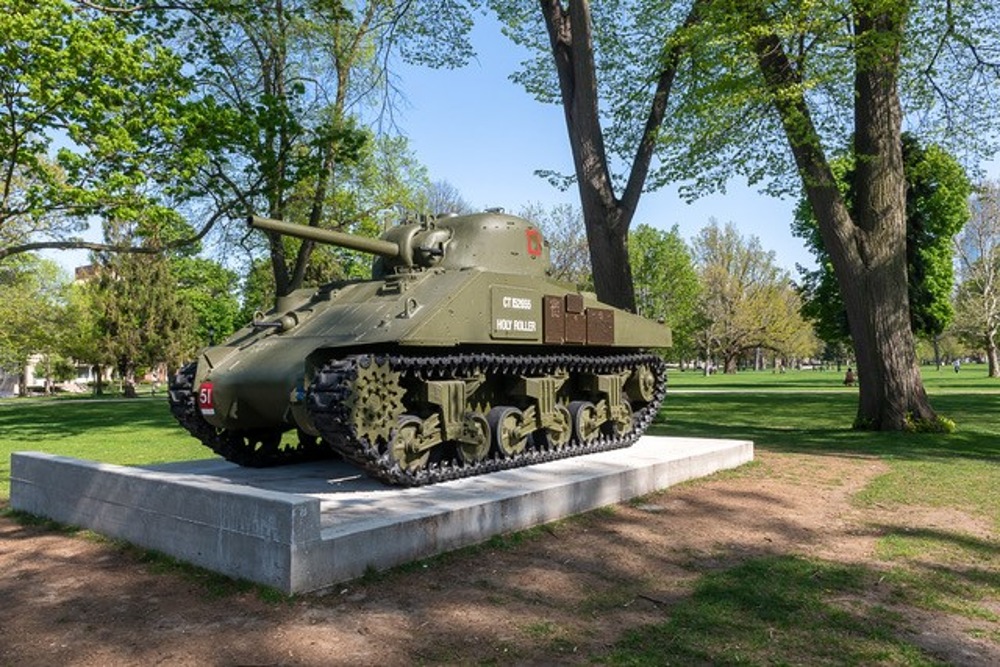- Period:
- Second World War (1939-1945)
- Rank:
- Captain
- Unit:
- 54th Light Aid Detachment, 6th Canadian Armoured Regiment (1st Hussars), 2nd Canadian Armoured Brigade, First Canadian Army, Canadian Army
- Awarded on:
- May 31st, 1945
- Awarded for:
- Operation Blockbuster
"On the 26th of February 1945 at the beginning of Operaration Blockbuster the 6th Canadian Armoured Regiment (1st Hussars) had one squadron in support of the 5th Canadian Infantry Brigade of the 2nd Canadian Infantry Division and two squadrons in support of the 8th Canadian Infantry Brigade of the 3rd Canadian Infantry Division. The fighting on the 8th Canadian Infantry Brigade front was particularly heavy and during the course of the day some 22 tanks were lost through enemy action, mines or bogged down. Realizing the seriousness of the situation early in the day, Captain Neil, Officer Commanding 54 LAD RCEME, took his recovery tanks to a postion behind the two squadrons and, acting entirely on his own initiative, began recovery work on the bogged down and mined tanks in an area subjected to heavy enemy artillery, machine gun and sniper fire. This work was done without covering fire or the assistance of mine detectors in a heavily mined area. In the late afternoon "A" Squadron, who had been in support of the 5th Canadian Infantry Brigade, were released having accomplished their task in the Calcar area and were ordered to rejoin the Regiment to support the 9th Canadian Infantry Brigade in their attack on Udem. The Squadron at this time had lost only three tanks on mines but on the move to the Regimental Area, lost eight more in the soft ground. The considerable distance between the two areas necessitated the splitting of the recovery section and recovery in "A" Squadron was under the command of the Regimental Technical Adjutant. Unfortunately, this officer was killed during his work by the explosion of a mine. Captain Neil immediately took over both tasks and with complete contempt for danger, set an example which had immediately responded to by his crews and by noon on the 28th all recoverable tanks that were still battle-worthy were returned to the Regiment. The Hussars were committed to Phase II of the operation on the morning of the 1st of March and from this point on, due to the enemy's indiscrimenate use of both anti-tank and Schu mines and the treacherous going, recovery became the most important feature of maintaining tank support for the infantry. The situation seemed hopeless at times and at last light on the 3rd of March, the Regimental strenght was 23 effective tanks. From these, one squadron was to be kept in reserve to support the 7th Canadian Infantry Brigade attack on Sonsbeck. The remaining tanks were to support the 9th Canadian Infantry Brigade who were passed through the 8th Canadian Infanry Brigade. The recovery section had worked from light to dark on the 3rd and at 2200 hours Captain Neil was ordered to make every effort to continue recovery at all costs. Despite the exhausted condition of his men this work was continued until 1800 hours on the 4th of March. From this point on squadron strenghts were maintained at 8 to 10 tanks. From the 26th of February to the 4th of March, Captain Neil and his crew recovered fifty-one tanks. This was an outstanding performance because this was not recovery in the ordinary sense but revovery across a boggy, mined battlefield where the battle was still raging and which was at all times subjected to extremely heavy artillery, machine gun and mortar fire. There is no doubt that this courafe and contempt for danger, his will-power and personality set such a high example to his crews that by their efforts, all squadrons were kept at the highest possible strenght. Due to this the Regiment was able to give the maximum support when called upon and maintain the momentum of the attack and bring the clearing of the west bank of the Rhine to a successful conclusion."





